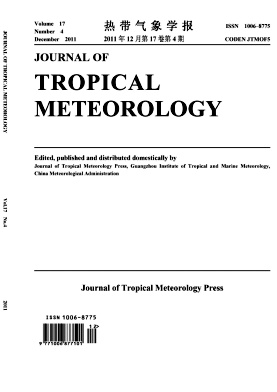-
Abstract:
Experiments of forecasting daily bi-variate index of the tropical atmospheric Madden–CJulian Oscillation (MJO) are performed in the context of adaptive filtering prediction models by combining the singular spectrum analysis (SSA) with the autoregressive (AR) methods. the MJO index, a pair of empirical orthogonal function (EOF) time series, called RMM1 and RMM2, predicts by the combined statistical SSA and AR models: firstly, according to the index of historic observation decomposed by SSA and then reconstructed by selecting the first several components based on prominent variance contributions; after that, established an AR prediction model from the composite (scheme A) or built the forecast models for each of these selected reconstructed components, separately (Scheme B). Several experimental MJO index forecasts are performed based on the models. The results show that both models have useful skills of the MJO index forecast beyond two weeks. In some cases, the correlation coefficient between the observed and predicted index series stays above 0.5 in 20 leading days. The SSA-AR model, based on the reconstructed composite series, has better performance on MJO forecast than the AR model, especially for the leading time longer than 5 days. Therefore, if we build a real-time forecast system by the SSA-AR model, it might provide an applicable tool for the operational prediction of the MJO index.
-
References
|
[1]
|
MADDEN R A, JULIAN P R. Detection of a 40-50 day oscillation in the zonal wind in the tropical Pacific [J]. J. Atmos. Sci., 1971, 28: 702-708. |
|
[2]
|
MADDEN R A, JULIAN P R. Description of global scale circulation cells in the tropics with a 40-50 day period [J]. J. Atmos. Sci., 1972, 29: 1109-1123. |
|
[3]
|
LI Chong-yin. Atmospheric Low-Frequency Oscilations [M]. Beijing: China Meteorological Press, 1993: 19-43 (in Chinese). |
|
[4]
|
LI Chong-yin. Research progresses in atmospheric intraseasonal oscillations [J]. Prog. Nat. Sci., 2004, 14(7): 734-741 (in Chinese). |
|
[5]
|
JIA Xiao-long, LI Chong-yin. Seasonal characteristics of tropical atmospheric intraseasonal oscillations and its behavior in the SAMIL-R42L9 model [J]. J. Trop. Meteor., 2007, 23(3): 219-228 (in Chinese). |
|
[6]
|
LIN Ai-lan, LIANG Jian-yin, GU De-jun. Research progresses in influence of tropical atmospheric intraseasonal oscillations on the East Asian monsoon region and its different time scale changes [J]. J. Trop. Meteor., 2008. 24(1): 11-19 (in Chinese). |
|
[7]
|
VON STORCH H, XU J. Principal oscillation pattern analysis of the tropical 30�C60 day oscillation. Part I: Definition of an index and its prediction [J]. Climate Dyn., 1990, 4: 179-190. |
|
[8]
|
LO F, HENDON H H. Empirical extended-range prediction of the Madden-Julian oscillation [J]. Mon. Wea. Rev., 2000, 128: 2528-2543. |
|
[9]
|
MAHARAJ E A, WHEELER M C. Forecasting an index of the madden-oscillation [J]. Int. J. Climatol., 2005, 25: 1611-1618. |
|
[10]
|
WHEELER M C, HENDON H H. An all-season real-time multivariate MJO index: Development of an index for monitoring and prediction [J]. Mon. Wea. Rev., 2004, 132: 1917-1932. |
|
[11]
|
National Weather Service (USA). MJO Monitoring and Forecast [EB/OL]. http://www.cpc.ncep.noaa.gov/products/people/wd52qz/mjoindex/ MJO_INDEX.html.[2009-01-15] |
|
[12]
|
Bureau of Meteorology Research Center (Australia). An All-season Real-time Multivariate MJO Index [EB/OL]. http://www.bom.gov.au/bmrc/clfor/cfstaff/matw/maproom/RMM/ [2009-01-15] |
|
[13]
|
VAUTARD R, YIOU P, GHIL M. SSA: A toolkit for short, noisy chaotic signals [J]. Phys. D., 1992, 58: 95-126. |
|
[14]
|
GHIL M, MO K C. Interseasonal oscillations in the global atmosphere [J]. J. Atmos. Sci., 1991, 48: 752-779. |
|
[15]
|
DING Yu-guo, JIANG Zhi-hong, ZHU Yan-feng. Experiment on short-term climatic prediction to SSTA over the Nino oceanic region [J]. J. Trop. Meteor., 1998. 14(4): 289-296 (in Chinese). |
|
[16]
|
JEONG Jee-hoon, KIM Baek-min, HO Chang-hoi, et al. Systematic variation in wintertime precipitation in East Asia by MJO-induced extratropical vertical motion [J]. J. Climate, 2008, 21: 788-801. |
|
[17]
|
DING Yu-guo, JIANG Zhi-hong. Signal Processing of Meteorological Data Time Series [M]. Beijing: China Meteorological Press. 1998. 91-172 (in Chinese). |
-
-
-

















 粤公网安备 4401069904700002号
粤公网安备 4401069904700002号
 DownLoad:
DownLoad: